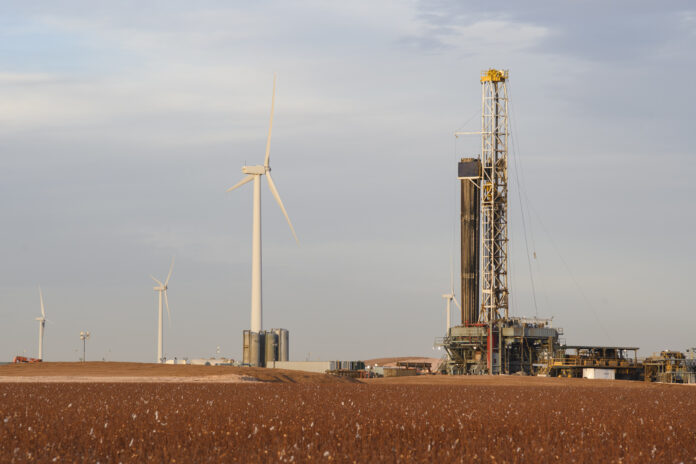
Presenting a dilemma that’s yet to be solved, the big whop, whop, whopping that wind turbines do is cutting wind farms’ electrical generation by as much as 30 percent.
Permian Basin International Oil Show President Larry Richards and Waco economist Ray Perryman say the importance wind has achieved in the renewable energy world gives finding a solution increasing importance.
“The percentage of U.S. electric power produced from wind energy eclipsed 10 percent last year, making wind power the No. 1 renewable power source and finally exceeding all those dams built in the 1940s and 1950s producing hydroelectric power,” Richards said. “Texas leads the way with roughly 17 percent of the state’s power now generated from wind turbines.
“But as wind power comes to scale, the inherent technical and engineering challenges begin to loom larger, limiting its reliability and efficiency. Studies have found that up to 30 percent of the power generation of a station can be lost due to the effects of wind turbulence and atmospheric fluid dynamics. Many stations simply don’t produce anywhere near the anticipated output.
“We’ve learned some wind dynamics can actually strip energy from the turbine and much of the incredibly complicated math required to solve the problem just doesn’t exist today.”
Richards said the nation’s requirements necessitate the aggressive pursuit of all forms of energy.
“Just as nothing in life worth having comes without sacrifice, no one source or technology comes without costs,” he said. “Wind power has its environmental impacts from the massive blades that fill landfills and never decompose to the strip mining often used to source the vast amounts of copper and other metals used in the turbines.
“A single wind turbine often contains up to 335 tons of steel, 4.7 tons of copper, three tons of aluminum and 700-plus pounds of rare earth minerals. Anyone who has ever been on a ranch that’s installed them knows the impact on flora and fauna while that huge infrastructure and road network is being built out.
“I believe wind power is an important element of our energy independence, but to think it comes without major negative environmental impacts is simply naive and untrue.”
Richards said he has spent much of his career developing technologies and processes to help extract and produce oil and natural gas “in a way that shows good stewardship of the environment and the natural resources we’ve been given.
“The majority of our electricity in the U.S. is produced from natural gas and I believe that will remain true for many, many decades,” he said. “It’s reliable, transportable, storable and by far the cleanest hydrocarbon-based energy source. We’ve proved it can be produced cost effectively with minimal emissions.
Richards said the pursuit of all energy sources, including wind power and natural gas, “requires us to constantly evolve in our pursuit to produce them in a way that is sustainable and environmentally conscious.
“The payoff is extraordinary,” he said. “The daily access to low-cost energy has lifted millions from poverty and given all Americans a standard of living that our ancestors could not have dreamed of.”
Noting that dealing with the turbulence problem entails the very complicated field of computational fluid dynamics, Perryman said, “The large wind turbines that are now coming into wide use generate wakes that extend well into the atmospheric boundary layer or basically the portion of the atmosphere that feels and reacts to turbulence on earth,
“Consequently, the wakes from some terminals can impact and degrade the output of other terminals behind them,” he said. “Fluid dynamics largely deal with the flow of liquids and gases, but the underlying mathematics are useful in this context as well. The measurements get a bit complicated, but the problems are solvable.”
Perryman said that where there is a market incentive, a solution can almost always be found.
“In the case of wind power there is a clear market incentive both from selling power and from the current slate of green incentives encouraging additional investment,” he said. “Moreover, the world is going to need to all types of energy going forward, which will further enhance incentives.”
Perryman said turbulence issues “are generally solvable with the proper engineering studies to determine optimal spacing.
“There are likely situations with existing farms where the installed base is positioned in such a way that the amount of power generated is lessened by turbulence,” he said. “This issue only began to surface and get attention as the turbines grew in size. It is certainly something that could be designed around even with large turbines in the future. Their wakes are nowhere close to the levels that can’t be mediated with existing laws of physics and some innovative designs.
“The wind power industry has been around for a while and is quite well established. The incentives to address this issue are in place and I am sure that solutions will be forthcoming. In fact, turbines may become even larger. That makes for some challenging mathematics, physics and engineering, but that rarely prevents progress where profits are involved.”



